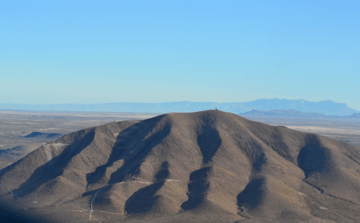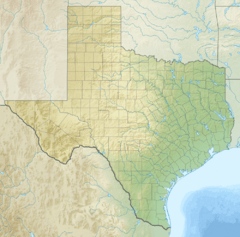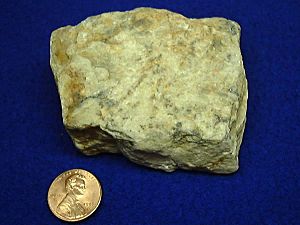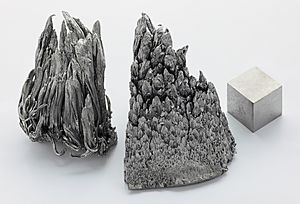Round Top Mountain facts for kids
Quick facts for kids Round Top Mountain |
|
|---|---|

Aerial view of Round Top Mountain in Texas
|
|
| Highest point | |
| Elevation | 5,732 ft (1,747 m) |
| Geography | |
| Topo map | USGS Round Top Mountain |
Round Top Mountain is a cool mountain in Hudspeth County, Texas, close to the town of Sierra Blanca. It's special because it holds lots of important minerals. It has deposits of beryllium and the biggest supply of heavy rare-earth elements in the whole United States!
Contents
Where is Round Top Mountain?
Round Top Mountain is in the Trans-Pecos area of West Texas. This part of Texas is very mountainous. It's northeast of the Mexican border. The area around Round Top Mountain is about 950 square miles wide.
Round Top Mountain is one of five peaks in the area that were formed in a special way. These mountains, called laccoliths, were made when hot, melted rock pushed up from underground but didn't break through the surface. The other peaks are Little Round Top, Little Blanca, Triple Hill, and Sierra Blanca.
The closest town to Round Top Mountain is Sierra Blanca, Texas. It's about 8 miles southeast of the mountain and has about 553 people. You can get there by Interstate 10. It's also about 85 miles east of El Paso, Texas.
Round Top Mountain is over a mile wide at its base. Its peak is about 1,000 feet higher than the flat desert around it. The top of the mountain is about 4,270 to 4,600 feet above sea level.
What is Round Top Mountain Made Of?

The Sierra Blanca area, where Round Top Mountain is, has many volcanic rocks. Round Top Mountain itself is made of a type of rock called rhyolite. This rock formed when molten liquid rock pushed up from deep inside the Earth. Over a long time, the top layers of softer rock wore away, showing the hard rhyolite underneath.
The mountain also has other materials like Del Rio Clay and Finlay limestone. You can also find deposits of uranium and lithium there. The area around the mountain has sandy soil and clay, which helps scrub bushes and grasses grow.
Scientists first explored this area in the 1970s. They found fluoride deposits. Later, in the 1980s, they discovered lots of beryllium, especially on the northwest side of Round Top Mountain. A study in 1988 suggested the mountain had about 298,000 tons of ore. This ore could produce about 11 million pounds of beryllium!
Round Top Mountain is also famous for its rare-earth elements. It has the largest deposit of heavy rare-earth elements in the United States, with over a billion tons estimated! These elements are super important. They are used in many things we use every day, like:
- Electronic devices (like your phone or computer)
- Lasers
- Equipment for oil and gas drilling
- Water treatment systems
- Things for energy and defense
The mountain contains 5 light and 10 heavy rare-earth elements. The heavy rare-earth elements in Round Top are special because they are found in a mineral called yttrofluorite. This type of deposit is very rare!
The Round Top Project
The Round Top Project is a big effort to get these valuable minerals from the mountain. It's a partnership between USA Rare Earth and Texas Mineral Resources Corporation (TMRC). Besides rare earths, the project also focuses on lithium, beryllium, and uranium. The U.S. government considers many of these minerals "critical" for national security and the economy.
The land where Round Top Mountain is located belongs to the Texas General Land Office. However, it was leased to Texas Rare Earth Resources in 2011. This allowed them to explore and develop the rare-earth elements there.
The United States used to be a top producer of rare-earth elements. But in the 1990s, other countries, especially China, could produce them cheaper. This led to many U.S. mines closing. Later, when China started limiting its rare-earth exports, the prices went way up. This made the U.S. look for its own sources again, like Round Top Mountain.
The Round Top Project plans to get the heavy rare-earth elements using a method called heap leaching. This involves crushing the ore and then using a special liquid (dilute sulfuric acid) to separate the elements. The mountain's natural rock allows the acid to soak in and reach the elements.
Environment Around Round Top Mountain
The area around Round Top Mountain has underground water. However, this water is too salty and full of minerals to drink. Most of the rain falls during thunderstorms in July and August. January through April are usually very dry.
In the summer, temperatures can reach 100°F during the day. But it gets cooler at night. Because of the breezes higher up on the mountain, the actual temperature can feel different. The area doesn't have many earthquakes, with only about one happening every 50 years.
Climate
| Climate data for Round Top Mountain (Sierra Blanca, Texas) | |||||||||||||
|---|---|---|---|---|---|---|---|---|---|---|---|---|---|
| Month | Jan | Feb | Mar | Apr | May | Jun | Jul | Aug | Sep | Oct | Nov | Dec | Year |
| Mean daily maximum °F (°C) | 58 (14) |
63 (17) |
69 (21) |
78 (26) |
87 (31) |
94 (34) |
92 (33) |
90 (32) |
87 (31) |
78 (26) |
67 (19) |
58 (14) |
77 (25) |
| Mean daily minimum °F (°C) | 26 (−3) |
29 (−2) |
35 (2) |
43 (6) |
52 (11) |
61 (16) |
64 (18) |
62 (17) |
56 (13) |
44 (7) |
33 (1) |
26 (−3) |
44 (7) |
| Average precipitation inches (mm) | 0.40 (10) |
0.68 (17) |
0.30 (7.6) |
0.33 (8.4) |
0.52 (13) |
1.13 (29) |
2.13 (54) |
2.15 (55) |
1.45 (37) |
1.15 (29) |
0.41 (10) |
0 (0) |
11.27 (286) |




